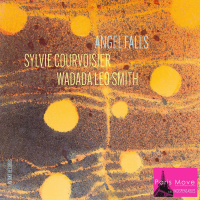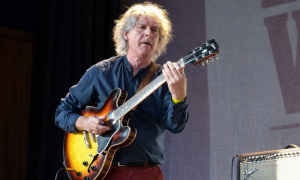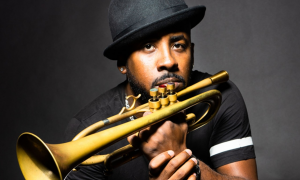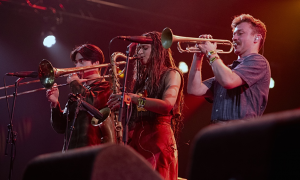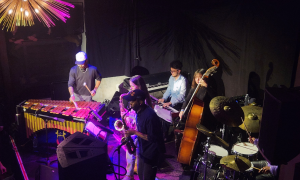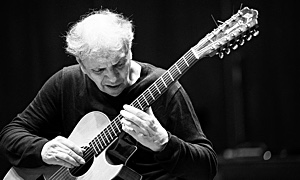Home » Jazz Articles » Live Review » Montreal Jazz Festival Day 7: July 4, 2007
Montreal Jazz Festival Day 7: July 4, 2007
For the second of its two guests (guitarist Mike Stern was the first) in the Invitation Series, the 2007 Festival International de Jazz de Montreal selected Richard Bona to perform four shows over four nights at Place Des Arts' Theatre Jean-Duceppe. Since emerging in the mid-1990s, the Cameroonian bassist's star has rapidly ascended, recording with artists (in addition to releases under his own name) such as legendary keyboardist Joe Zawinul, guitar icons Pat Metheny and George Benson, and popular singer Jane Monheit. It may seem odd that an artist so relatively young has been selected for the Invitation Series, but Bona's a remarkable artist who has obviously demonstrated already the kind of breadth that justifies the festival's decision to include him in the series.
Rounding out Day Seven was a stunning performance by guitarist John Abercrombie's current quartet, demonstrating how strong improvisers can take compelling material and make it fresh and unpredictable night after night.
Chapter Index
Richard Bona and the Jaco Pastorius Big Band
In recent years the music of the late bass legend Jaco Pastorius has entered the realm of repertory. His relatively small body of work, cut short when the sad life of this tortured genius ended prematurely in 1987 at the age of 35, has been mined by artists ever since his passing, but the formation of the Jaco Pastorius Big Band in 2003, under the leadership of Peter Graves, has devoted itself to interpreting not just the bassist's own compositions but tunes by others that became signature through his prodigious, memorable performances.
Pastorius' fretless electric bass innovations continue to be felt to this day, and Bona is one of many whose own style has been affected by Pastorius' remarkable ability to combine visceral groove and pedal-to-the-metal technical virtuosity—though Bona is, in fact, an even more impressive master. Bona has played on both Jaco Pastorius Big Band recordings—Word of Mouth Revisited (Heads Up, 2003) and The Word is Out (Heads Up, 2006)—so it's fitting that he should open his Invitation Series by paying tribute to one of his seminal influences, supported by the Jaco Pastorius Big Band.
Despite being an unequivocally stunning player, and with an enthusiastic crowd who seemed to know almost every tune that Bona and the band played, the show was not without its flaws. Graves' charts are strong, and his twelve piece band—four woodwinds, three trumpets, trombone, bass trombone, guitar, keyboards and drums (the group also has a regular bassist, Jeff Carswell, who sat out most of the show until the very end when he joined Bona on stage)—is made up of clearly capable players. The problem was that, while they navigated Graves' oftentimes challenging charts with ease, as soloists they often sounded generic. The big band had its moments, however—Ed Calle and Billy Ross delivering powerful saxophone solos throughout, and drummer Mark Griffith keeping the energy level up on tunes including Pastorius' "Teen Town" and "Punk Jazz."
Apart from the excessive divide between the Jaco Pastorius Big Band's au fait performance and Bona's staggering virtuosity, the big band's dynamic performance did give Bona enough to work with. And while Bona's style is clearly informed by Pastorius's innovations, he performed tunes including the greasy "Opus Pocus," the poignant yet dramatic "Three Views of a Secret" and the funky "Soul Intro/The Chicken" with a judicious combination of reverence and personal style. Bona also demonstrated a more lyrical side on Joe Zawinul's Weather Report ballad, "A Remark You Made."
Throughout the show Bona, speaking entirely in French, engaged the crowd between songs, responding to yells from the audience and providing background on the material. He also performed two of his own songs solo that, while lovely and demonstrative of his ability to make the bass a sole accompaniment instrument, felt out of place with a performance whose purpose was to honor Pastorius' legacy. Still, his mellifluous singing voice and, in particular, the second piece—where he scatted alongside rapid-fire lines covering the entire range of his five- string bass—were undeniably impressive and offered a taste of what to expect on his other three nights of the series. On the other hand, his singing on the up-tempo blues, "Fannie May," lacked the grit and abandon of Pastorius' looser delivery.
It may not have been perfect, but Bona's show with the Jaco Pastorius Big Band offered plenty to keep the audience more than happy, and was an engaging opener to the bassist's Invitation Series. class="f-right">
John Abercrombie Quartet
If Bona's show was a case of a great player teamed with a competent band, John Abercrombie's quartet of six years—violinist Mark Feldman, bassist Marc Johnson and drummer Joey Baron—was a prime example of how four individuals, each intuitive improvisers and leaders in their own right—can work together with an almost involitional chemistry, a shared understanding and the comfort of knowing that anything and everything is possible—and allowed.
It was also an opportunity to see the difference between some artists who, when faced with a problem, roll with it and just keep on moving forward, as opposed to others, who are unable to deal with even the slightest upset. Abercrombie experienced a significant technical issue early in the set with one of his amplifiers (not noticeable to the sold-out house, but affecting him and, consequently, the way he felt he played), but at a temporary stop in the show he made light of it, joking that "I should be complaining to my wife or my therapist; instead, here I am in front of three or four hundred people saying 'What the f*&k is going on?"
It was that kind of levity that characterized the entire performance, which used material from the quartet's three releases—Cat 'n' Mouse (ECM, 2002), Class Trip (ECM, 2004) and Third Quartet (ECM, 2007)—as a starting point for explorations that often went to completely unexpected places.
Beginning with Third Quartet's "Banshee," the democratic nature of the quartet was instantly established. Abercrombie may be the ostensible leader and composer of most of the music, but this was a truly collective, four-way conversation between musical friends who never got in each other's way. Instead, everyone listened carefully to what was going on around them, responding either in concert or by trying to gently shift the direction of the dialogue.
On record Abercrombie's music may reflect a sparer aesthetic, but live there was a greater energy and sense of playful mischief that made the entire 105-minute set a pleasure from start to finish. Eye contact was fundamental, with Baron, in particular, keeping a close watch on everything taking place from his central position on the stage at the 400-seat Gesu theatre. The quartet's ability to begin a tune like "Wishing Well," also from The Third Quartet, in a more abstract fashion, then ultimately and magically allowing it to coalesce into its lyrical theme was what made the show a highlight of the 2007 festival.
Cat 'n' Mouse's "On the Loose," which closed the set, grooves hard on record, but in performance the group took considerably greater liberties. Baron is rapidly becoming one of the most versatile drummers on the scene, an unpredictable player capable of anything from a whisper-like touch to the more raucous energy displayed here. Following its idiosyncratic theme, Baron immediately launched into a rock and roll beat, with the rest of the group quickly joining in and turning it into a powerful blues with Abercrombie's distortion-laced tone. But as quickly as the hard and heavy groove appeared it dissolved into a duet between Baron and Feldman, whose unfettered solo referenced everything from Aaron Copland to gypsy jazz.
Another high point of the set was the quartet's take on Ornette Coleman's "Round Trip." Again, the group took its time finding its way to Coleman's slightly skewed theme, with Abercrombie's solo the perfect combination of distinctive linearity and chordal movement. The band pulled out for Feldman's solo, another tour-de-force that could come only from an artist who has worked with everyone from John Zorn to Loretta Lynn. From staggering lines to high pitched harmonics, what impresses most about Feldman is his total control of his instrument.
Feldman's solo led to a feature for Johnson. While the bassist—who often created a firm but flexible anchor that gave Baron considerable freedom—contributed a number of virtuosic solos throughout the set, here he demonstrated that soloing, in the hands of someone who is pursuing a musical idea rather than looking to impress, can redefine where the rest of the group goes. Playing a slow, visceral bass line suggesting a greasy blues, he was soon joined by the rest of the band. Just when the biggest question was how the group would find its way back to Coleman's theme, Abercrombie managed to locate a path and, seemingly all of a sudden, everyone was back on the tune. Clearly this is a band with nothing to prove.
Abercrombie's a guitarist who, while having considerable cachet in the jazz community, is still not as big a name as, say, Pat Metheny, John Scofield or Bill Frisell. It's a shame since, while all those guitarists clearly come from the jazz tradition, Abercrombie is the one who remains most consistently within the sphere of that tradition while, at the same time, pushing against its edges to expand it into areas less traveled. Abercrombie's Gesu performance was confirmation of his intrepid spirit, collaborative approach and, as was clear with everyone in the quartet, an artist for whom humor and fun are equal parts of music that is also not without depth and significance.
Tomorrow: Meshell Ndegeocello and Richard Pinhas.
Day 1 | Day 2 | Day 3 | Day 4 | Day 5- 1 | Day 5-2 | Day 6 | Day 7 | Day 8 | Day 9 | Day 10 | Day 11
Tags
Richard Bona and the Jaco Pastorius Big Band / John Abercrombie Quartet
Live Reviews
John Kelman
Canada
PREVIOUS / NEXT
Support All About Jazz
 All About Jazz has been a pillar of jazz since 1995, championing it as an art form and, more importantly, supporting the musicians who make it. Our enduring commitment has made "AAJ" one of the most culturally important websites of its kind, read by hundreds of thousands of fans, musicians and industry figures every month.
All About Jazz has been a pillar of jazz since 1995, championing it as an art form and, more importantly, supporting the musicians who make it. Our enduring commitment has made "AAJ" one of the most culturally important websites of its kind, read by hundreds of thousands of fans, musicians and industry figures every month.









